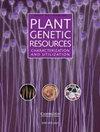Evaluation of phenological development and agronomic traits in exotic common bean germplasm across multiple environments
IF 0.7
4区 生物学
Q3 PLANT SCIENCES
Plant Genetic Resources: Characterization and Utilization
Pub Date : 2023-08-29
DOI:10.1017/s1479262123000618
引用次数: 0
Abstract
Twenty-nine exotic common bean germplasms and three elite cultivars were examined for phenotypic diversity in two bean-producing environments (Kanpur and Shimla) across three winter seasons and one rainy season. The estimate of genetic variability parameters revealed that the exotic bean germplasm has enough diversity for all the evaluated features. The highest genotypic and phenotypic coefficients of variation were found in seed yield, followed by 100-seed weight, pods per plant and pod length. Furthermore, seed yield was the most heritable and genetically advanced quantitative feature, followed by 100-seed weight, pod length and pods per plant. According to a trait association study, the days to maturity of phenological traits have a strong positive correlation with the days to initial flowering and the days to 50% flowering. Pods per plant and seeds per pod most strongly influence increased grain yield. The first two principal components accounted for 63.3% of the variation and demonstrated significant diversity among exotic bean lines for the traits studied, according to the principal component analysis. According to the hierarchical clustering analysis, 29 accessions and three cultivars were divided into three groups. Cluster I contains early flowering and maturing accessions, while cluster III contains high pods per plant and an increased grain yield of germplasms. The fundamental source of phenological fluctuations in both environmental circumstances is temperature. This study found four genetically divergent and stable performance accessions, including EC932021, EC932189 (earliness), and EC931452, EC931971 (high grain yield), which may aid in the establishment of a bean breeding programme.不同环境下外来豆种质物候发育及农艺性状评价
对29份外来普通豆种质和3个优良品种在坎普尔和西姆拉两个产豆环境中3个冬季和1个雨季的表型多样性进行了研究。遗传变异参数估计表明,外来豆种质资源具有足够的多样性。籽粒产量的基因型和表型变异系数最高,其次是百粒重、单株荚果数和荚果长。籽粒产量是最具遗传性和遗传先进性的数量特征,其次是百粒重、荚果长和单株荚果数。性状关联研究表明,物候性状的成熟期与初花期和50%花期有较强的正相关关系。单株荚果和单荚种子对籽粒产量的影响最大。主成分分析表明,前两个主成分占变异量的63.3%,所研究性状在外来豆系间表现出显著的多样性。通过分层聚类分析,将29份材料和3个品种分为3个类群。集群I包含早开花和成熟的品种,而集群III包含单株高荚果和籽粒产量增加的种质。在这两种环境条件下物候波动的基本来源是温度。本研究发现了4个具有遗传差异且性能稳定的品种,包括EC932021、EC932189(早熟品种)和EC931452、EC931971(高产品种),这可能有助于建立大豆育种计划。
本文章由计算机程序翻译,如有差异,请以英文原文为准。
求助全文
约1分钟内获得全文
求助全文
来源期刊

Plant Genetic Resources: Characterization and Utilization
Agricultural and Biological Sciences-Agronomy and Crop Science
CiteScore
2.80
自引率
0.00%
发文量
29
审稿时长
>12 weeks
期刊介绍:
Plant Genetic Resources is an international journal which provides a forum for describing the application of novel genomic technologies, as well as their integration with established techniques, towards the understanding of the genetic variation captured in both in situ and ex situ collections of crop and non-crop plants; and for the airing of wider issues relevant to plant germplasm conservation and utilisation. We particularly welcome multi-disciplinary approaches that incorporate both a technical and a socio-economic focus. Technical aspects can cover developments in technologies of potential or demonstrated relevance to the analysis of variation and diversity at the phenotypic and genotypic levels.
 求助内容:
求助内容: 应助结果提醒方式:
应助结果提醒方式:


